During the late 19th century, newspaper and magazine articles tended to skirt the subject of practical self-defence. The popularity of feature articles on that subject was spurred by Edward Barton-Wright’s Bartitsu series for Pearson’s Magazine in 1898-99 and continued through to the outbreak of the First World War. By the late 1920s, they had almost become passé.
This Popular Mechanics feature on the subject of self-protection against “rogues and stick-up men” offers a compilation of street-fighting tricks ranging from the common-sense to the somewhat fanciful, though the author’s emphasis on quick thinking and improvisation under pressure is as valid now as it was during the roaring ’20s.
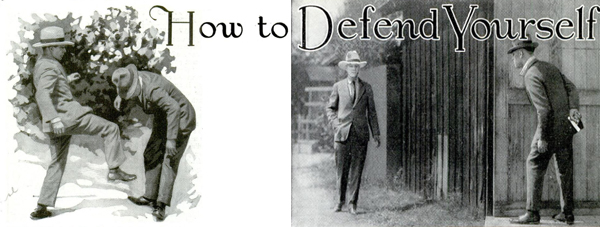
Strategy is more effective than strength if one only knows how to use it in a dealing with bullies, ruffians or holdup men. A frail five-foot man can, figuratively, make a whipped dog out of a seven-foot rogue if he knows how to use his brain to make up for his inferiority in physical power.
There is even a way to prevent being held up at the point of a gun which is about 90% effective, if one only knows the trick. That is the simple expedient of keeping one or both hands in one’s pocket while passing through locations where a hold-up might be attempted.
No bandit, except one bereft of his senses, or with a reckless disregard for retaining a whole hide, would ever try to hold up a man who’s right hand reposes languidly in his coat pocket. The bandit has no knowledge that the hand in the pocket may not repose upon the butt of a pistol. The wise stickup-man therefore chooses for his victim one who can be told to “reach for the sky” without the possibility of bringing a trigger-finger unexpectedly into action.
No blanket rules can be set down to offer complete defense against the attacks of strong-arm bandits and bullies, but a generalization of methods of defense can be made which will serve almost every purpose. First of all, it should be remembered that all rules of fair play have no part in dealing with an adversary who is obviously outside the pale of law and order and public decency.
The problem of the person on the defensive is that of getting the best of the attacker by brain work and doing it in the quickest and most effective way.
The element of surprise movement is just as important to an individual seeking to defend himself as it has always been with armies. Catching the enemy unawares, and upon a quarter where he never anticipated and attack, is always one of the surest ways of getting the best of him. Thus, the big bully who launches an assault upon a person of lesser physique is usually taken completely off his guard when the little fellow hauls off with a quick fist and plants a blow squarely in the pit of his opponent’s abdomen. When this happens, the fellow who received the blow usually fold up like a jackknife, and spends the next 2 or 3 minutes gasping for breath, or howling with pain. We say that such a blow “knocks the wind out of one.” It does that figuratively but not literally. The jolt from even a fairly weak abdominal punch is absorbed by the intestines, the spleen and the lower part of the stomach. There are no bones to protect these vital organs from serious, or even fatal, injury. A blow of equal force could be landed upon the chest without the slightest injury to the recipient.
Next among body blows for putting an attacker out of combat, the groin is about the most vulnerable part of the body. Moreover, a bully or rogue seldom expects his harmless-looking victim to make use of his feet in defending himself. He is therefore taken completely off his guard, and is knocked out cold when the intended victim lets fly with the point of a shoe which catches him in the groin. If the person on the defensive has heavy shoes, the kick is all the more effective.

Umbrellas, canes, walking sticks, hat pins and many other articles which people commonly carry may be used as thoroughly efficient weapons for repelling the most vicious attack, if one knows just how to wield them. A person who is attacked while carrying an umbrella usually makes the mistake of attempting to use it as a club. A clubbed umbrella is scarcely more dangerous than a big feather, but the same umbrella, if thrust into an attacker’s face, automatically becomes a dangerous javelin that will gouge out an eye, rip the nose, or tear into the mouth or cheeks like a sword. An umbrella with the point dressed down by a few strokes of a file is also a terrible weapon when used javelin-fashion.
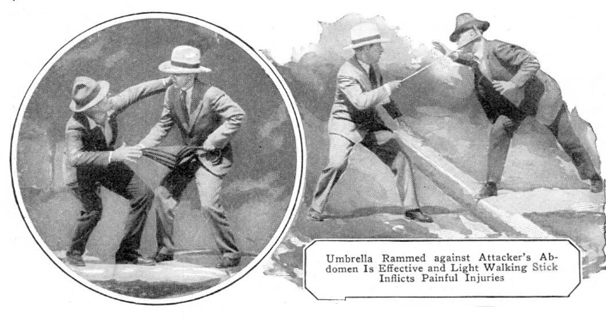
The intended victim of an attacker, who carries a cane or walking stick, usually clubs down upon his opponent in an effort to defend himself. It would require a very heavy cane to inflict in a serious injury by a downward swing of that instrument. An arm suddenly raised will ward off the blow completely. But, let the walking stick welder swing his improvised weapon horizontally, like a Chinaman will let drive with a broadsword, and even a light walking stick becomes a dangerous, or even deadly, weapon. With a cane swung horizontally, the man defending himself is more apt to catch his assailant unexpectedly. The blow is aimed upon the side of the head, and a good stiff jolt there will make a huge bullies see stars. It may break an eardrum, or cave in the side of the skull at a point where it is very thin. If the blow can be landed slightly below and a little behind the ear, even a light walking stick will crush the skull.
Fist blows aimed at the face are effective, but as a means of self-defense are not so good, especially since the average ruffian is usually something of a pugilist, and probably of a physique superior to his intended victim. The little fellow, therefore, should endeavor to defend himself, bearing in mind that fingernails gouging at his enemy’s eyes are more apt to inflict serious injury than a small weak fist bringing up against a hard lantern jaw. Hat pins, for women who wear them in these days of a small hats and bobbed hair, are, and always have been, potential weapons of self defense. They are to the owner, when wielded in the direction of an opponent’s eyes, precisely what the cat’s claws are in turning an angry dog. Women and girls who are annoyed by “mashers” have the most effective means of curtailing such an annoyance by cool-headed wit. Instead of displaying antagonism, they have but to feign approval – and then pass the annoyer over to the nearest police department.
In cases of personal combat, when the person on the defensive has been seized, or has clinched with the antagonist, the most effective defense available is to make quick and decisive use of one’s teeth. A study of police records of hundreds of attack cases reveals the fact that only one person in 50 ever seems to remember to bite the assailant when there is no other available method of besting him. Yet many instances also are recorded of persons who have completely defended themselves from attacks by making use of the teeth. A physically weak person can easily trim a finger off the hand of a husky rogue, or will make such a dent in his hand or arm that he’ll think of nothing but the pain.
Among classes of persons who frequently have occasion to act in self-defense, newspaper reporters and photographers probably top the list. They are constantly called upon to interview or photograph persons who don’t desire to be interviewed or photographed. Arguments and attacks are the logical outcome. There are innumerable opportunities for such squabbles, but they are always avoided by using a few of the repelling methods known to every newspaper man. Some of these methods are worth reciting here because they can be adopted or modified to meet the requirements of most persons in moments of urgent self-defense.
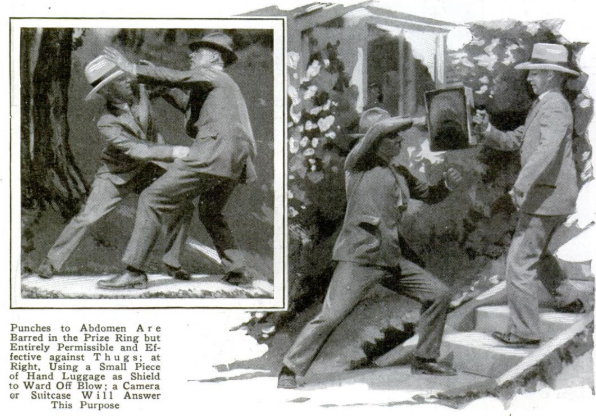
The newspaper photographer’s ever handy weapon of defense is the very camera that so often gets him into trouble. Few would expect a press photographer to use his camera either as a shield or as a weapon, but such use of it has the tremendous advantage of surprise. A 15 pound camera when suddenly lifted to shield one’s face from a fist blow offers splendid protection, as well as shock-absorbing qualities that will probably cause more damage to the fist than to the camera itself. Likewise, the same camera, when swung by the handle, becomes a weapon that will crack a head – or, better still, send that the opposing party scurrying beyond harm’s Way. The reporter’s favorite weapon is a lead pencil held like a dagger against the ball of the thumb and thrust in the direction of the antagonist’s face. No sane person will risk an eye against such an implement. Hence the threat in most cases ends the encounter before active warfare begins.
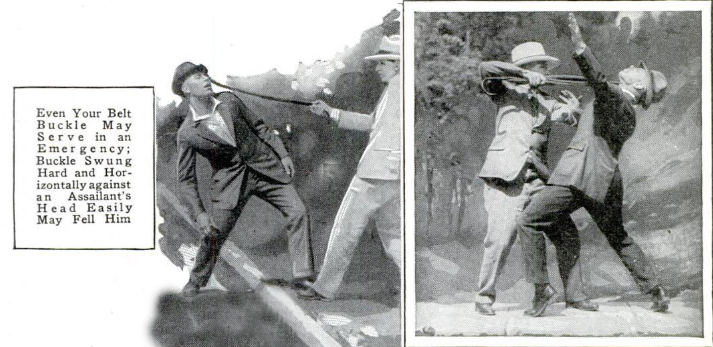
In the development of improvised weapons of self defense there are absolutely endless possibilities, depending, of course, largely upon the resourcefulness and initiative of the individual. Pins, belts with metal buckles, a shoe jerked off the foot and clubbed by the toe end, sticks, stones, tin cans, glass tableware and crockery that can be conveniently broken to make a jagged edge, and many other things, are recorded among articles that have been pressed into service by persons desperately in needs of defense. Wit and self-reliance are, indeed, the most powerful mediums for self-protection when it must be individually furnished.
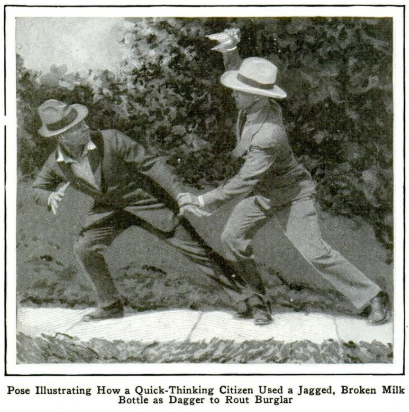
Many suggestions are contained in police records of persons who have avoided indignities by means of quick wit. A few of these are listed for the valuable knowledge they may offer to others. A physician, who makes numerous calls at all hours of day and night, carries an ounce of red pepper done up in oiled paper, sewed into cheesecloth, and tide on the end of a buckskin thong.
Another, almost humorous incident of self-defense was that of a little fellow who was being set upon by a big bully as the result of their respective automobiles having locked fenders. The bully attempted to administer a chastisement upon the driver of the other car, but got a reception entirely unexpected. The little fellow grabbed a small hand fire extinguisher off the dash of his machine, then squirted his attacker in the face with the highly volatile fluid. A policeman who arrived on the scene to investigate the traffic jam found the bullying motorist rubbing his eyes, gasping for breath, and rid of all thought of personal combat.
We would hardly think of a strand of wire as an instrument for overpowering a bandit and delivering him into the hands of the police, but at least one incident of that sort has been recorded. A man was coming home one night when he was attacked by a footpad. A sharp scuffle followed during which the intended victim of the attack became entangled with a wire. Quick to think and act, he got the wire off his own feet and succeeded in taking a turn around the bandit’s neck with the thin strand of metal. After that, strangling the attacker into submission and leading him to the nearest police call box was the work of a few minutes.
